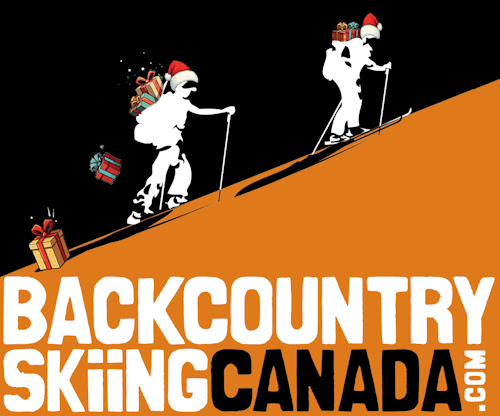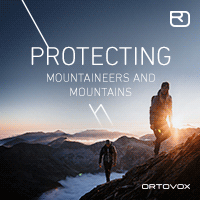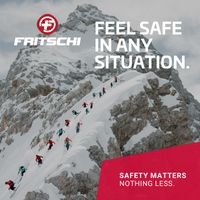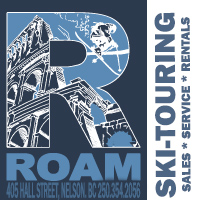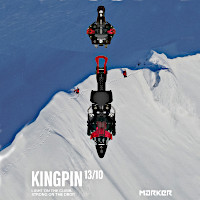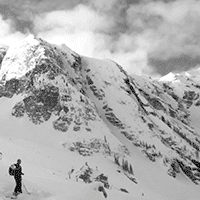


SITE LOGIN
- REVIEWS
- NEWS
- STORE
- ROUTES
- LODGING
-
VIDEOS
- 2022/23 Gear Reviews
- 2021/22 Gear Reviews
- 2020/21 Gear Reviews
- 2019/20 Gear Reviews
- 2018/19 Gear Reviews
- 2017/18 Gear Reviews
- 2016/17 Gear Reviews
- 2015/16 Gear Reviews
- 2014/15 Gear Reviews
- 2013/14 Gear Reviews
- 2012/13 Gear Reviews
- 2011/12 Gear Reviews
- 2020 Outdoor Retailer
- 2019 Outdoor Retailer
- 2018 Outdoor Retailer
- 2017 Outdoor Presscamp
- 2017 Outdoor Retailer
- 2016 Outdoor Presscamp
- 2016 Outdoor Retailer
- 2015 SIA Show
- 2014 Outdoor Retailer
- 2013 SIA Show
- 2012 Outdoor Retailer
- Tips and Tricks
- Backcountry Skiing
- SAFETY
- ABOUT
- REVIEWS
- NEWS
- STORE
- ROUTES
- LODGING
-
VIDEOS
- 2022/23 Gear Reviews
- 2021/22 Gear Reviews
- 2020/21 Gear Reviews
- 2019/20 Gear Reviews
- 2018/19 Gear Reviews
- 2017/18 Gear Reviews
- 2016/17 Gear Reviews
- 2015/16 Gear Reviews
- 2014/15 Gear Reviews
- 2013/14 Gear Reviews
- 2012/13 Gear Reviews
- 2011/12 Gear Reviews
- 2020 Outdoor Retailer
- 2019 Outdoor Retailer
- 2018 Outdoor Retailer
- 2017 Outdoor Presscamp
- 2017 Outdoor Retailer
- 2016 Outdoor Presscamp
- 2016 Outdoor Retailer
- 2015 SIA Show
- 2014 Outdoor Retailer
- 2013 SIA Show
- 2012 Outdoor Retailer
- Tips and Tricks
- Backcountry Skiing
- SAFETY
- ABOUT
TOP VIDEOS
AVALANCHE SKILLS TRAINING
Backcountry Skiing Canada has reprinted the description of the Avalanche Skills Training (AST) Program below with the kind permission of the team at the Canadian Avalanche Centre (CAC). Programs offered by various instructors follow the guidelines outlined here. The CAC is the acknowledged expert in the field of avalanche education for recreational backcountry users. We have chosen to focus on the Level 1 and 2 AST courses because they will likely interest our site’s visitors the most. The CAC’s sister organization is the Canadian Avalanche Association (CAA) and that’s where you’ll find a comprehensive professional training programs for those who work, or are planning to work, in avalanche risk management. To learn more about either of these organizations and all their services and good works, visit their respective sites.
This from the CAC:

Avalanche Skills Training (AST) Level 1 Course
AST Level 1 courses have a minimum of 7 hours of classroom instruction plus one full day in the field. This course, developed with the generous assistance of the National Search and Rescue Secretariat, covers the fundamentals of backcountry avalanche awareness and companion rescue. Here’s an example:
The Avalanche Skills Training Level 1 Course will provide an entry-level decision-making framework that is based on the most advanced knowledge available. It is suitable for use by people with basic training and little experience.
In addition, the course will:
Provide the prerequisite knowledge required for further avalanche training.
Introduce and promote the Avalanche Skills Training Level 2 Course as the logical next step for gaining intermediate-level decision-making skills.
Objectives:
At the end of the course, students should be able to:
- Understand the basics of avalanche formation and release.
- Identify avalanche terrain.
- Know the steps required to plan and carry out a trip.
- Use the Avaluator™ as a decision-making tool in areas where trips are rated using the Avalanche Terrain Exposure Scale (ATES) and where Avalanche Danger Ratings and Avalanche Bulletins are available.
- Find resources for obtaining ATES terrain ratings if their trip is not rated.
- Find resources for obtaining Avalanche Danger Ratings and Avalanche Bulletins if these are not available.
- Use appropriate travel techniques in avalanche terrain.
- Carry out a companion rescue.
- Understand the limits of their training.
Minimum Classroom Time Requiremens:
A minimum of seven hours classroom time is required.
Minimum Field Time Requirement:
A minimum of one day in the field is required.
Avalanche Skills Training (AST) Level 2 Course
AST Level 2 courses offer a minimum of 9.5 hours of classroom studies and 3 days of field instruction. Some instructors may offer AST Level 2 that is up to seven days in duration. Here’s an example:
The Avalanche Skills Training Level 2 Course will provide an intermediate level decision-making framework that is based on the most advanced knowledge available. It is suitable for use by people with a moderate degree of training and experience.
In addition, the course will:
Provide the prerequisite knowledge required for further avalanche training.
Introduce and promote the Canadian Avalanche Association Industry Training Program as the accepted standard for advanced avalanche training.
Objectives:
At the end of the course, students should be able to:
- Use the Avaluator™ as a filtering tool to determine when additional planning and travel techniques are required to travel safely.
- Be familiar with Avalanche Danger Ratings verification techniques for personal use on a local scale.
- Be familiar with the ATES technical model as a means to develop personal, local terrain ratings.
- Use routefinding to take advantage of nuances in terrain to manage personal risk.
- Use travel techniques in avalanche terrain appropriate to the avalanche conditions.
- Proficiently carry out a companion rescue.
- Understand the limits of their training.
Minimum Classroom Time Requiremens:
A minimum of 9.5 hours classroom time is required.
Minimum Field Time Requirement:
A minimum of three days in the field is required.
Fortunately, there are many instructors around the country who are qualified to teach AST classes. We have provided some examples here, but our list is far from exhaustive. To learn more about AST programs in your area, visit the Canadian Avalanche Centre (CAC). To learn the specifics about individual courses offered, follow the links to instructor websites and read the details about what they offer.
Summit Mountain Guides:
David Lussier, IFMG/ACMG Mountain Guide, Nelson BC, 250.354.4884
Read a full review of their AST 1 course in our review section over here and their AST2 course here.
Mountain Sense:
Shaun King, Nelson BC, 403.707.5566
Choosing an Avalanche Course
Guest article by David Lussier, certified IFMGA Mountain Guide and owner/operator of Summit Mountain Guides.
November has shown all the exciting signs that another snowy winter is underway. Down in the valleys the once vivid foliage has fallen to the ground, the daylight hours are decreasing and the temperatures have cooled off. Winter has already made an appearance in the valleys over the last few weeks with a welcome dump of snow in town and arctic temperatures. With all the natural elements aligned, the human excitement is slowly building with anticipation of another great winter in the mountains.
The mountain environment is rightfully praised and cherished by backcountry enthusiasts. It is an amazing place to connect with nature while exercising. The snow-covered winter landscape, full of contrasts, offers tremendous outdoor recreation opportunities. As much as the winter mountain environment can be a rewarding place, it can also be a dangerous place. One of the main hazards facing winter recreationists in the mountains is avalanches. Statistics speak for themselves, every year there is an average of 14 avalanche fatalities in Canada. To put the odds in your favor, learn to make better decisions in avalanche terrain and, to raise your avalanche awareness level, some avalanche training is highly recommended.
When it comes to avalanche training and education, the Canadian Avalanche Association (CAA) is a world leader. In recent years, the CAA has done a tremendous amount of work to standardize and simplify courses and curriculums. They have set high standards to help guides and educators provide the public with some highly effective avalanche awareness skills.
Generally speaking, avalanche training is either recreational or professional. The recreational avalanche courses are for the general public and people interested in gaining avalanche awareness skills for their personal backcountry adventures. The professional avalanche courses are intended for people who aspire to or already work in the avalanche industry. Both categories offer various levels of courses depending on your skills and goals.
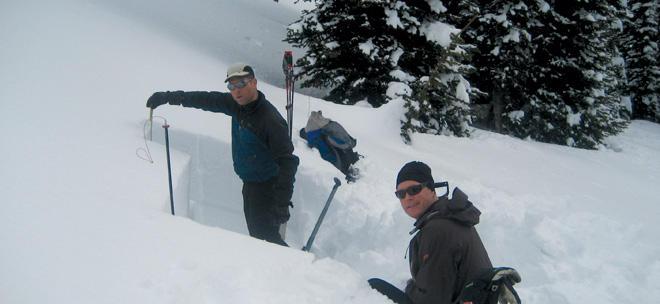
Recreational Avalanche Courses
The one day avalanche awareness course is entry-level training. This course covers some of the skills required to head into the backcountry including: backcountry safety, etiquette and resources, how to recognize and avoid avalanche terrain as well as basic avalanche safety gear use (beacon, probe & shovel). Many organizations offer this course throughout western Canada. In the Kootenay region, Avalanche Awareness Beyond the Boundaries is a non-profit society that provides free Avalanche Courses to youth aged 13– 18.
The Avalanche Skills Training series (AST 1 & 2) are more in depth programs for backcountry skiers, boarders and snowmobilers. AST courses, formerly known as Recreational Avalanche Courses, have become the accepted recreational model since 2006. They have been developed by the CAA in an effort to improve avalanche safety in Canada. One of the main goals of the AST courses is to provide a decision making framework for recreationists based on the most advanced knowledge available. The curriculum has been streamlined to represent the changing techniques and bring awareness to recourses available so the public can make better decisions when planning a trip or while in avalanche terrain.
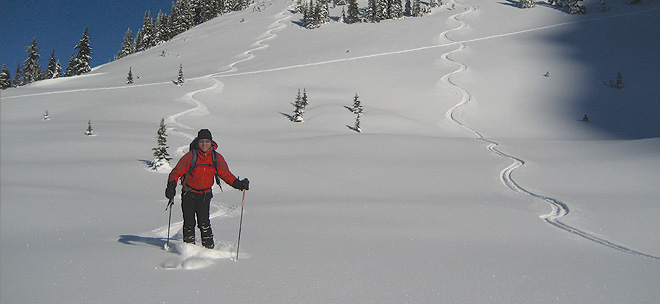
The AST 1 course involves about 8 hours of classroom and at least one day in the field. It is ideal for people interested in learning the decision making process and what resources are available and necessary to increase safety when planning a trip or while in avalanche terrain. This is a great course whether you are just starting up or want to refresh your skills with current techniques and up to date resources. The price for this course varies greatly depending on length, instructor skills and training and location of the program. The AST level 1 is a steeping stone for further industry training (i.e. AST 2 and Professional Avalanche Courses).
The AST 2 is a longer course involving about 8 hours of classroom and a minimum of 3 days in the field. It is geared for experienced recreationists interested in refining their decision making skills. Unlike the AST 1, one of the goals of the AST 2 course is to learn how to adapt personal exposure based on the changing avalanche conditions. This is where recreationists will learn about the subtleties in the snowpack, avalanche bulletins, terrain variations, and changing weather patterns and their impact on terrain choices in avalanche terrain. AST 2 is the highest level of recreational training available in Canada. To do this course it is recommended that you have completed the AST 1 course as the material is a continuum and a basis for further training.
There are various levels of instructor experience; for recreational courses instructors have usually completed at least one of the professional avalanche courses. They may also be tied to a particular aspect of the avalanche industry: mountain guiding, avalanche control, or avalanche risk management programs. As avalanche training is highly experiential, when choosing a company or school, consider the professional experience of the instructor.
Instructors teaching 1 or 2 day courses are required to have completed the professional Level 1 course while AST 2 instructors will have completed the Level 2 course and are a professional member of the CAA. For a list of the current avalanche courses in your location, visit the training section of the CAA website: www.avalanche.ca/cac. In the West Kootenay region, there are many AST 1 & AST 2 providers; in Nelson, programs are offered each month by ski and mountain guides, for more information visit www.summitmountainguides.com.
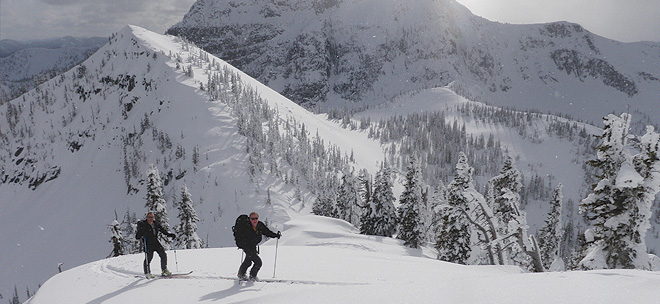
Professional Avalanche Courses
The CAA has developed a thorough and chronological training program for avalanche workers called the Industry Training Program, which includes the “Avalanche Operations Level 1, 2 & 3 courses”. The “Avalanche Operations Courses” provide the academic and practical foundation for avalanche professionals in Canada. These courses are intended for people who aspire to or already work in the avalanche industry such as in snow safety evaluation, avalanche control, avalanche research, avalanche education, mountain guiding, and winter search & rescue operations. Each of these courses is much more expensive and time consuming (they vary in length from 1 to 2 weeks) than a recreational course. Students develop a wide range of skills, build a resume of practical field experience, and learn from some of the most experienced instructors in the the avalanche risk management industry.
The CAA “Avalanche Operations Level 1” course is the entry level course for professionals and the basis for further industry training. It is the logical 1st step for those interested in working in the avalanche industry. Participants must be advanced skiers or split-boarders and should have considerable backcountry travel experience to comply with rising industry standards. Participants must have completed a minimum of one recreational AST courses (preferably both). This intensive 7 to 8 day technical training course is comprised of approximately 40% theory and 60% practical field work. The field work is regarding the formation and nature of avalanches, personal and group safety measures, significant properties of the mountain snowpack, organized search & rescue, recognizing avalanche terrain, operational risk management and decision making as well as the collection & recording of weather, snowpack and avalanche occurrence data. To better represent the various aspects of the industry, this course is available, in different formats, geared either to skiers, snowmobilers, search and rescue personnel or educators. Upon successful completion of the program, participants will have the necessary skills to begin a career in the avalanche industry.
“Avalanche Operations Level 2” course is an advanced 14 day program for people who work full time with avalanche safety, control operations and guiding. Participants must have at least 100 days of operational field experience making and collecting weather data, snowpack information, and avalanche activity observations before applying. This generally requires at least two years of active operational field work and experience under the mentorship of more experienced CAA Professional Members. “Avalanche Operations Level 3” course is very new 5 day course intended for senior position avalanche workers employed in forecasting, risk management, and/or planning positions. For more information on curriculum and prerequisites for these advanced levels, visit www.avalanche.ca/cac.
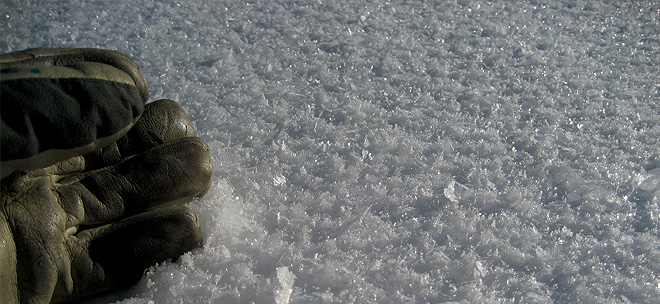
The Process
Mountain recreation in a winter environment is rewarding and exhilarating. It teaches us a great deal about ourselves and our environment. In those moments of bliss, it is often easy to forget about common sense. Through avalanche education, it is possible to gain a proper knowledge base for better decision making in avalanche terrain. The process for better knowledge and experience is lengthy and a journey in itself. Most of the courses offered in Canada target a broad audience and offer a great learning progression.
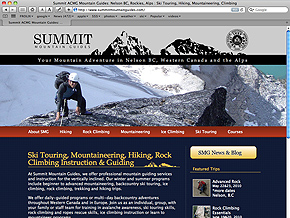
As in many things, knowledge teaches us the rules and experience teaches us the exceptions. The avalanche world is no different; in fact, it seems like the more we know, the more there is to know. Through this process we gain a better risk awareness perception. Since the level of risk associated with backcountry skiing is high, being humble and adapting to the constantly changing surroundings is key to survival. A good dose of avalanche training will surely play in your favour too!
Have fun learning and enjoy a safe winter!
David Lussier is a fully certified IFMGA Mountain Guide and Professional Member of the Canadian Avalanche Association. He lives is Nelson with his family where he operates his guiding business, Summit Mountain Guides. (All photo by David Lussier)
Backcountry skiing is an inherently dangerous activity that requires experience and knowledge to travel safely. Any of the routes on this site may be dangerous depending on conditions. You are responsible for your own safety in the backcounty—the team behind backcountryskiingcanada.com disclaim any responsibility for any injury resulting from people travelling on routes described on this site. To read our Terms of Use and get all the details, read HERE.
Copyright © 2009-25 Backcountry Skiing Canada. All Rights Reserved.
